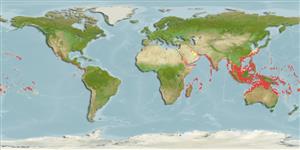Common names from other countries
>
Anguilliformes (Eels and morays) >
Muraenidae (Moray eels) > Muraeninae
Etymology: Gymnothorax: Greek, gymnos = naked + Greek, thorax, -akos = breast (Ref. 45335).
More on author: Lacepède.
Environment: milieu / climate zone / depth range / distribution range
Ecología
marino; salobre asociado a arrecife; rango de profundidad 0 - 110 m (Ref. 58302). Tropical; 32°N - 28°S
Indo-Pacific: Red Sea and East Africa, including Walters Shoal (Ref. 33390) and Persian Gulf (Ref. 68964) to French Polynesia, north to southern Japan and the Hawaiian Islands, south to the southern Great Barrier Reef. Eastern Central Pacific: Costa Rica and Panama (Ref. 9324).
Length at first maturity / Tamaño / Peso / Age
Maturity: Lm ?, range 77 - ? cm
Max length : 150 cm TL macho / no sexado; (Ref. 1602)
Espinas dorsales (total) : 0; Radios blandos dorsales (total) : 0; Espinas anales: 0; Radios blandos anales: 0; Vértebra: 126 - 138. Distinctive pattern of light undulating lines and speckles on a dark green background. Snout often yellow (Ref. 30404).
A common species on reef flats among rocks, rubble, or debris and also occurs in lagoons and seaward reefs to depths of 26 m or more. Minimum depth reported taken from Ref. 86942. Cavernicolous (Ref. 8593, 58302). Benthic (Ref. 58302). Nocturnal species that feeds on fishes, octopi, and probably crustaceans. Reported to be an aggressive species and prone to bite. Used in Chinese medicine (Ref. 12166).
Life cycle and mating behavior
Maturities | Reproducción | Spawnings | Egg(s) | Fecundities | Larva
Chen, H.-M., K.-T. Shao and C.T. Chen, 1994. A review of the muraenid eels (Family Muraenidae) from Taiwan with descriptions of twelve new records. Zool. Stud. 33(1):44-64. (Ref. 6934)
IUCN Red List Status (Ref. 130435)
CITES (Ref. 128078)
Not Evaluated
Threat to humans
Reports of ciguatera poisoning (Ref. 4690)
Human uses
Pesquerías: escaso valor comercial; Acuario: Comercial
Herramientas
Special reports
Download XML
Fuentes de Internet
Estimates based on models
Preferred temperature (Ref.
115969): 24.3 - 29, mean 28 (based on 1810 cells).
Phylogenetic diversity index (Ref.
82804): PD
50 = 0.5000 [Uniqueness, from 0.5 = low to 2.0 = high].
Bayesian length-weight: a=0.00065 (0.00041 - 0.00103), b=3.28 (3.15 - 3.41), in cm Total Length, based on LWR estimates for this species & Genus-body shape (Ref.
93245).
Nivel trófico (Ref.
69278): 3.6 ±0.3 se; based on diet studies.
Resiliencia (Ref.
120179): Muy bajo, población duplicada en un tiempo mínimo superior a 14 años (Preliminary K or Fecundity.).
Fishing Vulnerability (Ref.
59153): Very high vulnerability (90 of 100).
